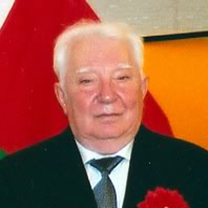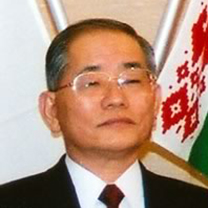The 4th Award Profile of the Recipient

Name
Evgueni Demidchik

Name
Evgueni Demidchik
(Head of the Thyroid Tumors Department of the Research and Clinical Institute for Radiation Medicine and Endocrinology of the Ministry of Health of the Republic of Belarus)
(Academician, National Academy of Sciences of the Republic of Belarus)
● Major Academic and Work Background :
January 2, 1925 Born in Minsk Region, The Republic of Belarus
1958-1965 Head of the Surgical Department of the Regional Hospital in Mogilev (Republic of Belams)
1965- 1966 Head of the Radiosurgery Department of the Research and Develoment Institute for Oncology and Medical
Radiology in Minsk (Republic of Belarus)
1966- 1997 Head of the Oncological Clinic and Head ofthe Department of the Minsk State Medical Institute
I 997-200 I Head of the Thyroid Tumors Department of the Research and Clinical Institute for Radiation Medicine and
Endocrinology
● Major Achievements and Activities:
1990 Establishment of the Belarussian Research and Practical Thyroid Tumor Centre in order to develop medical
treatment for the victims of radiation exposure after the Chemobyl accident and for the research of radiationinduced
thyroid cancer.
1992 Firstly reported the increase of childhood thyroid cancer after the Chemobyl accident. (Nature v.359)
1996 Development and introduction of techniques of radical surgical treatment of children with thyroid cancer.
Establishment of bank oftumor tissues for future research and investigation.
1998 Proved the necessity to apply preventive neck
lymphodissection for radiation-induced thyroid cancer.
● Main Reasons for Selection
Dr. Demidchik is a well-known and world-famous thyroid surgeon, who has devoted himself for a long time to patients with thyroid cancer, especially children after the Chernobyl Nuclear Plant Accident and even during the critical period of the catastrophe in the former USSR.
He has contributed a lot to establishing the Minsk Thyroid Cancer Center in the Republic of Belarus.
Dr. Demidchik has fIrst reported the rapid increase of childhood thyroid cancer in the international scientific joumal, NATURE, in 1992 and coordinated many international projects on Chemobyl Thyroid Cancer, these achievements have been highly evaluated in the world.
More specifically, he has introduced and maintained successfully radioisotope therapy, I-131 , to patients with operated childhood thyroid cancer.
Dr. Demidchik is of novel character and highly respected. He is now 76 years-old but still supervises actively in the frontline of thyroid surgery for radiation-exposed patients.
Therefore, Dr. Demidchik has been highly evaluated as the most suitable winner for the 4th Annual Nagasaki Dr. Nagai Peace Memorial Prize.

Name
Nanao Kamada

Name
Nanao Kamada
● Career Overview
March 20, 1937: Born
March 1961: Graduated from the Medicine Program at the Hiroshima University School of Medicine
July 1970: Obtained a doctorate in medicine (Nagasaki University)
1962: Assistant at the First Clinical Department of the Research Institute for Radiation Biology and Medicine
1976 – 1985: Associate professor at the Institute
1985 – 2000: Professor in the Hematology Research Department of the Institute
1997 – 1998: Director of the Institute
2001: Chairman of the Hiroshima A-Bomb Survivors Relief Foundation
● Major Activities
1963: Elucidated characteristics of leukemia in A-bomb survivors
1969: Proved the persistence of radiation scars
1972: Elucidated post-radiation injury
1988: Researched and worked toward the abolition of nuclear weapons as the director of the Japanese branch of IPPNW (International Physicians for the Prevention of Nuclear War)
1992-1999: Conducted internships for foreign healthcare workers engaged in treating victims of radiation exposure as director and chairman of the Hiroshima International Council for Health Care of the Radiation-Exposed
● Main Reasons for Selection
Dr. Kamada has, throughout his career, overcome all kinds of technical difficulties in researching atomic bomb survivors to prove that the bone marrow of healthy survivors retains chromosomal abnormalities twenty years after the atomic bombing, which has served as the scientific basis for the subsequent treatment of atomic bomb survivors.
In his research into leukemia among atomic bomb survivors, molecular biological analyses that he conducted revealed pathological differences between normal leukemia and leukemia in A-bomb survivors, renowned as world-class research. This research has proven at the molecular level that leukemia and cancer common among atomic bomb survivors are caused by exposure to radiation, serving as the scientific basis for attributing harmful effects to the atomic bomb.
Meanwhile, in his social activities, he has made it his mission as a scientist to convey the radiation damage seen in Hiroshima to the world as a member and then director of the Japanese branch of International Physicians for the Prevention of Nuclear War (IPPNW).
Since 1991, he has served as secretary, secretary-general, and chairman of the Hiroshima International Council for Health Care of the Radiation-Exposed (HiCARE), involved at the leadership level in a variety of projects and devoting himself to the medical treatment of those exposed to radiation and educating the public about the harmful effects of radiation.
In this way, Dr. Kamada has, in addition to producing wide-spanning research on hematological abnormalities in atomic bomb survivors, consistently devoted himself to humanitarian efforts from the standpoint of an atomic bomb survivor.
Indeed, from a scientific perspective, his achievements not only in helping build a foundation for medical treatment of atomic bomb survivors but in disseminating information about the harmful effects of the atomic bomb in an effort to create world peace without nuclear weapons are on par with the work of Dr. Demichek, who was involved in efforts at Chernobyl, and he has been selected as the most deserving recipient of the Takashi Nagai Memorial Nagasaki Peace Award.
